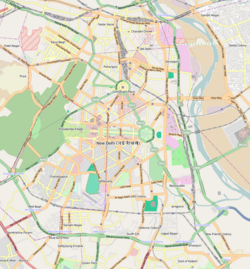| Hazrat Nizamuddin Dargah | |
|---|---|
 Amir Khusrau's tomb (left), Nizamuddin Dargah (right) and Jamaat Khana Masjid (background) | |
| Religion | |
| Affiliation | Sunni Islam |
| Sect | Sufism |
| Festivals | Urs (17th–18th of Rabi' al-awwal ) |
| Ecclesiastical or organizational status | Dargah and mosque |
| Ownership | Delhi Waqf Board |
| Status | Active |
| Location | |
| Location | Amir Khusro Gate, Nizamuddin West, New Delhi, Delhi NCT |
| Country | India |
Location of the dargah and mosque complex in Central Delhi | |
| Geographic coordinates | 28°35′29″N77°14′31″E / 28.59140°N 77.24197°E |
| Architecture | |
| Architect(s) | Sunni Khilji |
| Type | Mosque architecture |
| Style | |
| Completed |
|
| Specifications | |
| Direction of façade | West |
| Dome(s) | Many (unqualified number) |
| Shrine(s) | One |
| Materials | Red sandstone |
| Website | |
| nizamuddinaulia | |
| Official name | Baoli at Ghiaspur (also known as Nizamuddin Baoli) |
| Reference no. | N-DL-54 |
| Official name | Tomb of Amir Khusro, Ghiaspur |
| Reference no. | N-DL-56 |
| Official name | Tomb of Nizamuddin Auliya, Ghiaspur No. 197 |
| Reference no. | N-DL-58 |
| Official name | Grave of Jahanara Begum |
| Reference no. | N-DL-124 |
| Official name | Grave of Mohammed Shah |
| Reference no. | N-DL-125 |
The Hazrat Nizamuddin Dargah [1] is the dargah and mosque complex of the Sufi saint Nizamuddin Auliya, located in the Nizamuddin West area of Delhi, India. The dargah, or mausoleum, is a Sufi shrine and is visited by thousands of pilgrims every week. [2] The site is also known for its evening qawwali devotional music sessions. [3] [4]
Contents
- Architecture
- Dargah
- Jamat Khana Masjid
- Baoli
- Location
- Culture
- Management
- Gallery
- See also
- References
- Further reading
- External links
The complex comprises the Hazrat Nizamuddin Dargah, including several tombs, the Jamat Khana Masjid (or Khilji Mosque), and a baoli . Many of the structures are Monuments of National Importance, [5] administered by the Archaeological Survey of India. [1]






